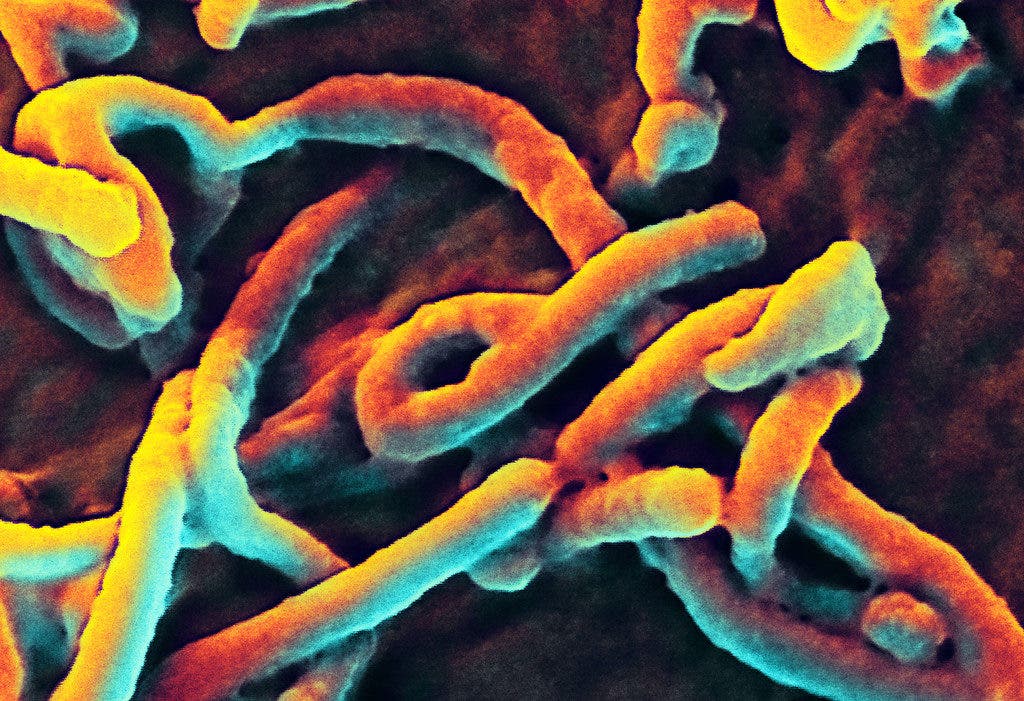The devastating Ebola outbreak in the Democratic Republic of the Congo (DRC) is probably over, health officials report.

Scanning electron micrograph of Ebola virus budding from the surface of a Vero cell (African green monkey kidney epithelial cell line).
Image and captions credits to NIAID / Flickr.
On May 8, 2018, the Democratic Republic of Congo’s health minister declared an outbreak of Ebola. The highly deadly disease had killed over 11,000 people in West Africa between 2014 and 2016, so everybody was, understandably, Not Very Excited. However, I’m sure everyone will be jubilating for this tidbit: the outbreak in Congo is almost assuredly over.
Ebo-naaaah
The outbreak in DRC was the most severe since the 2014-2016 event, but it’s probably over. As of Wednesday, all individuals who came into contact with the last-confirmed infectee have passed the 21-day incubation period of Ebola without showing any signs of infection themselves. Because of this, health officials don’t need to monitor anyone on a daily basis. However, they want to be extra-safe — so they will keep monitoring the situation for another three weeks before officially declaring the outbreak over.
A total of 38 cases were confirmed during the outbreak and 14 deaths. A further 15 deaths may be tied to the outbreak, but the link can’t be confirmed as of yet. All suspected cases over the past three weeks have turned out to be negative.
Before the outbreak can be officially declared over, two incubation periods (42 days) must pass without any new confirmed case.
The outbreak was first declared on May 8, as a cluster of cases was confirmed in the deep rainforests of DRC’s Equateur province. The virus made its way to Mbandaka — a city of 1.2 million and an important local transport hub along the Congo and Ruki rivers, both heavily navigated — three weeks after the first cases were confirmed.
Although Ebola is endemic to Congo’s jungles — so health officials here are world-leading experts in containing the virus — it was a nerve-wracking time for health officials, as Ebola is very hard to contain in densely populated areas. The possibility of it spreading down the two rivers further complicated containment efforts.
“This outbreak has been the most challenging and complex outbreak the country has ever had to face, mainly because it started in two rural zones at the same time and quickly reached a city of more than 1 million inhabitants directly connected to Kinshasa, our capital city where 12 million Congolese live,” DRC’s minister of health, Oly Ilunga, told The Washington Post.
“Yet thanks to a rapid national and international mobilization as well as a great government-led coordination of the response, we managed to contain this outbreak in just seven weeks.”
The minister further explained that authorities tracked and monitored over 1,706 people confirmed or suspected to have contacted infected individuals. The process (known as ‘contact tracing’) required authorities to establish a vast surveillance network to track people’s movements from town to town and report any cases of fever that could be Ebola.
In this particular outbreak, however, tracing teams also worked to identify candidates for an experimental Ebola vaccine that had only been used once before, in the waning days of the West African epidemic. Over 3,300 people were ultimately administered the vaccine. Ilunga considers the vaccine nothing short of a “game-changer.”
The news certainly calls for celebration — but they are far from a definite end to the disease.
“As Ebola is a virus whose natural reservoir is located in the Equatorial Forest, we must prepare ourselves for the 10th Ebola outbreak,” said Ilunga.
“Moreover, with the greater mobility of the population, we can expect to have other outbreaks in urban zones in the future. We must learn the lessons from this response and strengthen our system in order to detect and respond even more efficiently to the next outbreak.”









